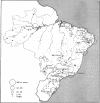Abstract
In a large-scale seroepidemiological study, the prevalence was determined of antibodies to influenza A viruses in the sera of military representative of the inhabited geographical regions of Argentina, Brazil and Colombia. The micro-haemagglutination-inhibition test was used against the Swine, PR/8, FM/1 and Asian antigenic strains. From each of the three recruit populations 500 sera were tested.
Positive titres to the FM/1 and Asian strains were found in 72% and 80% respectively of the Colombian sera, in 56% and 69% of the Argentinian sera, and in 49% and 63% of the Brazilian sera. Of these 1500 sera, 5 were positive to the PR/8 strain and 2 to the Swine strain.
This study also showed that there were highly significantly greater proportions of positive reactors to the FM/1 and Asian strains among persons of blood groups O and B than among those of blood group A in all three countries.
Full text
PDF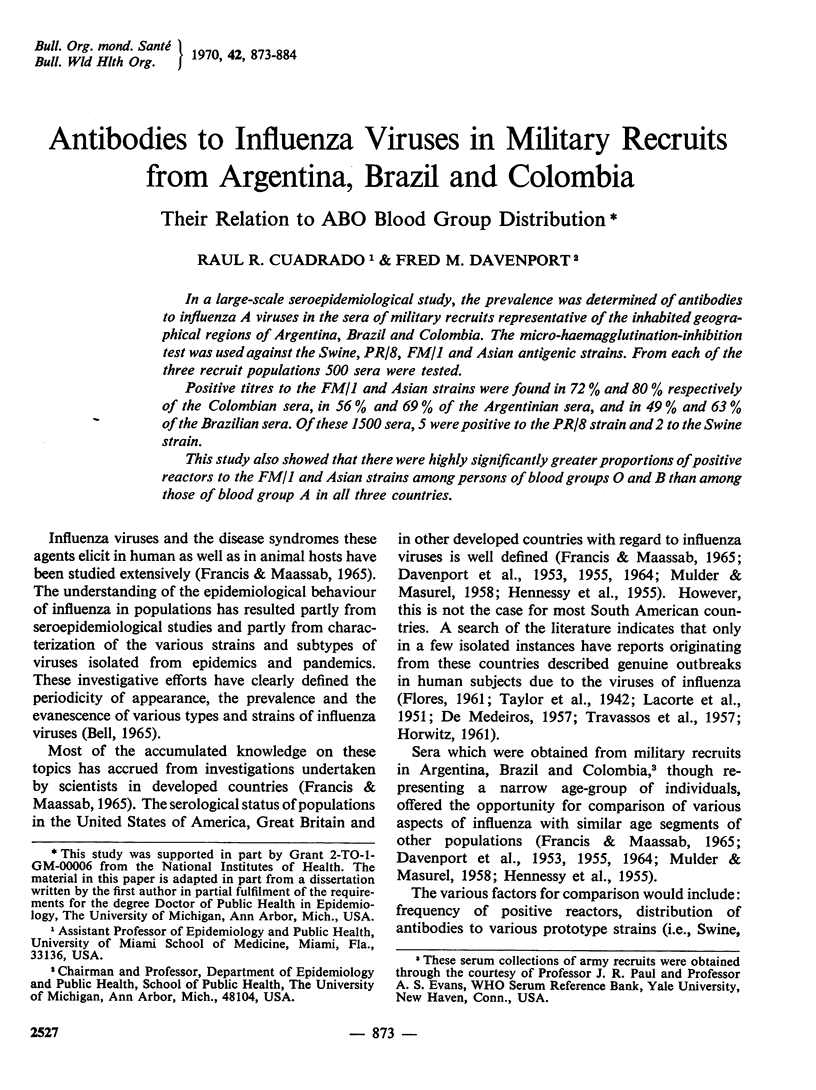
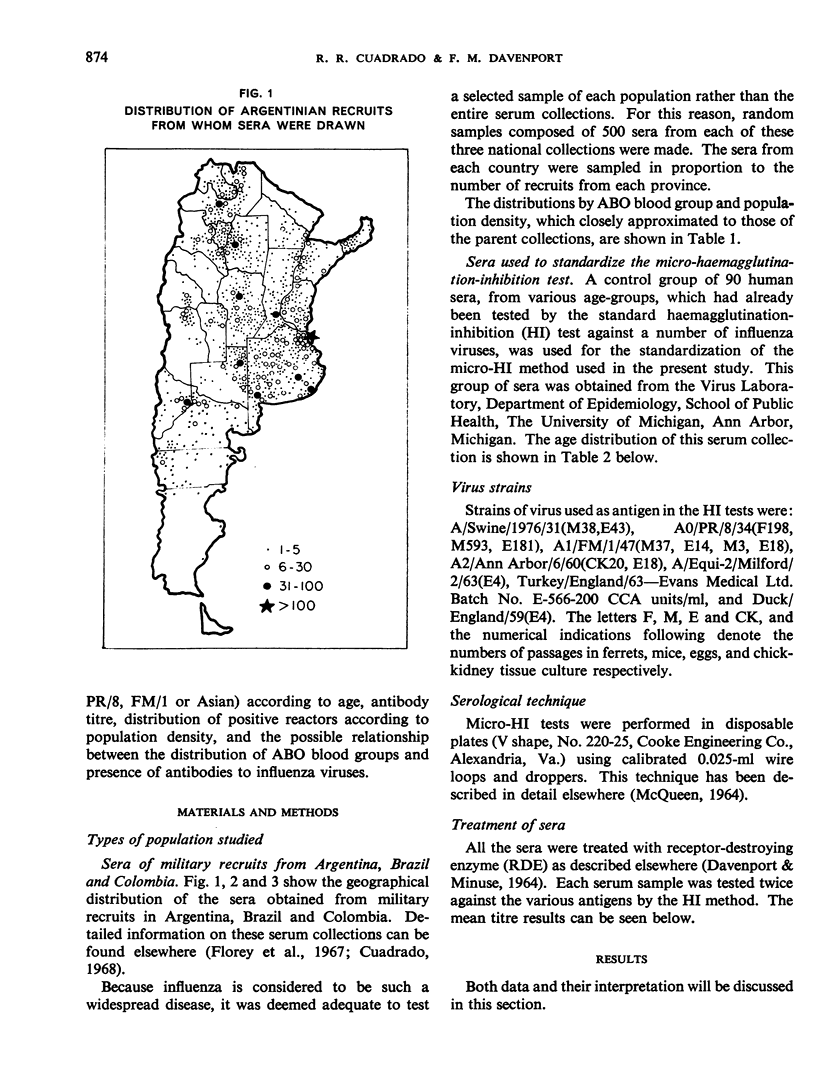
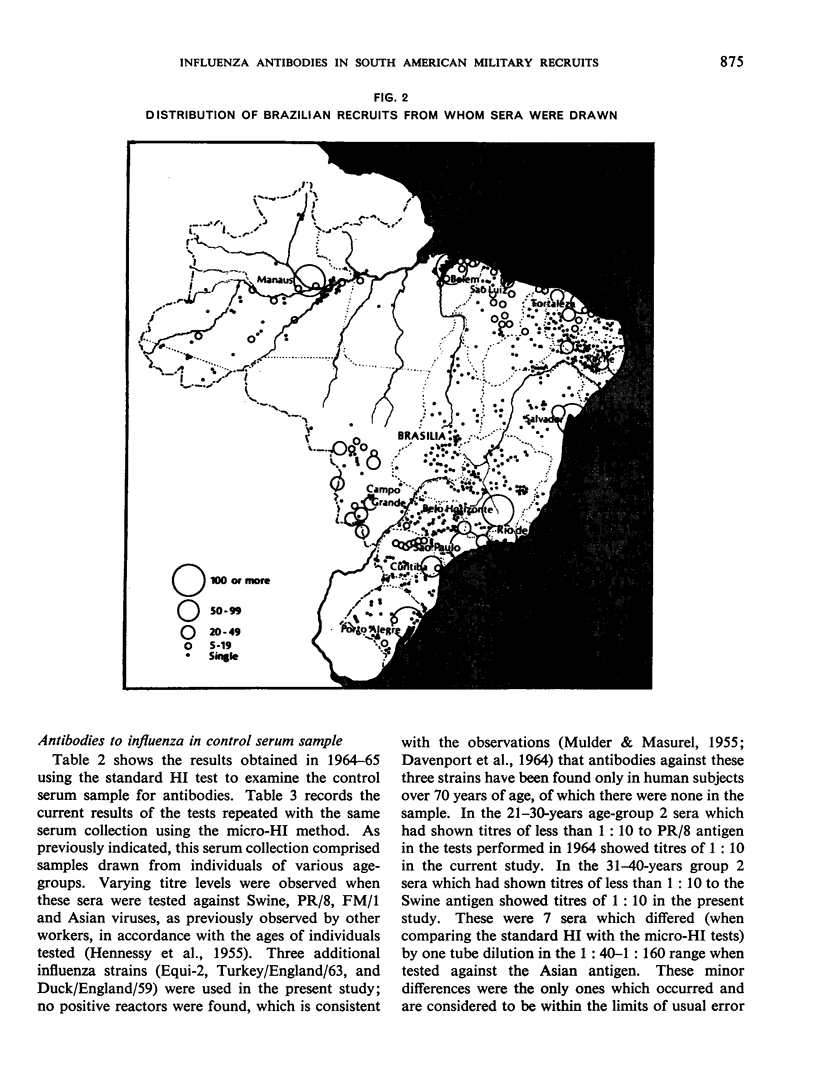
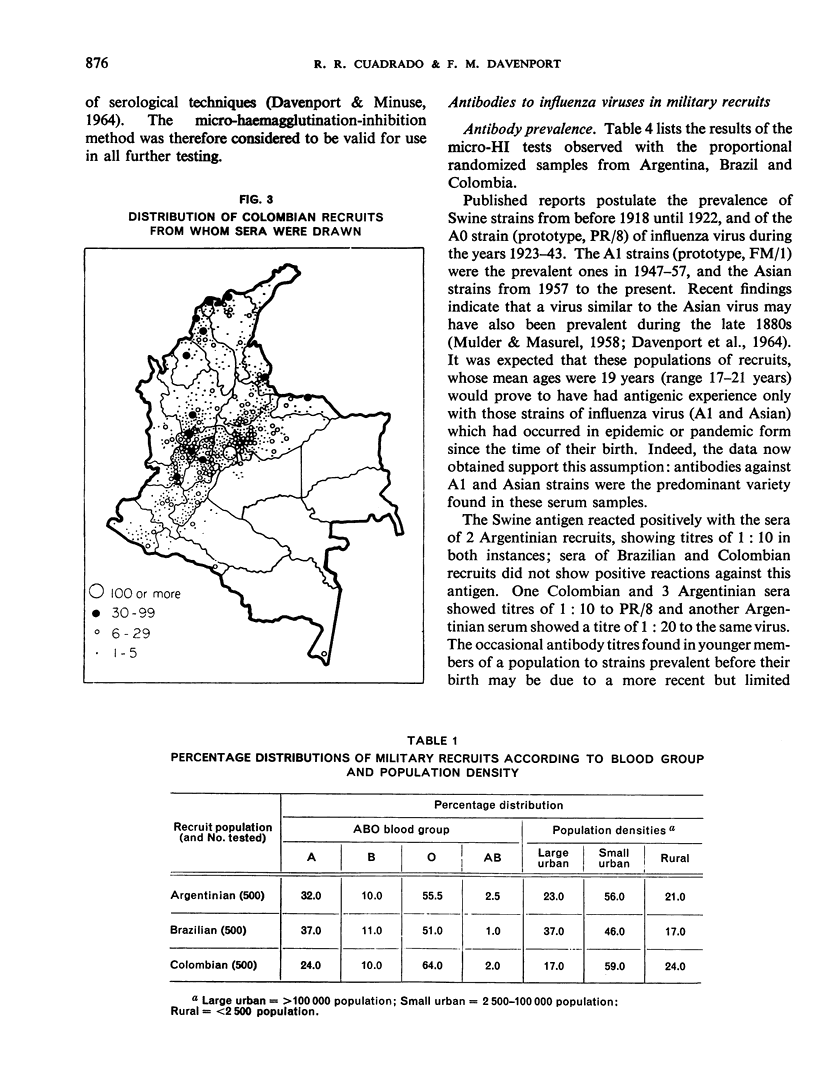
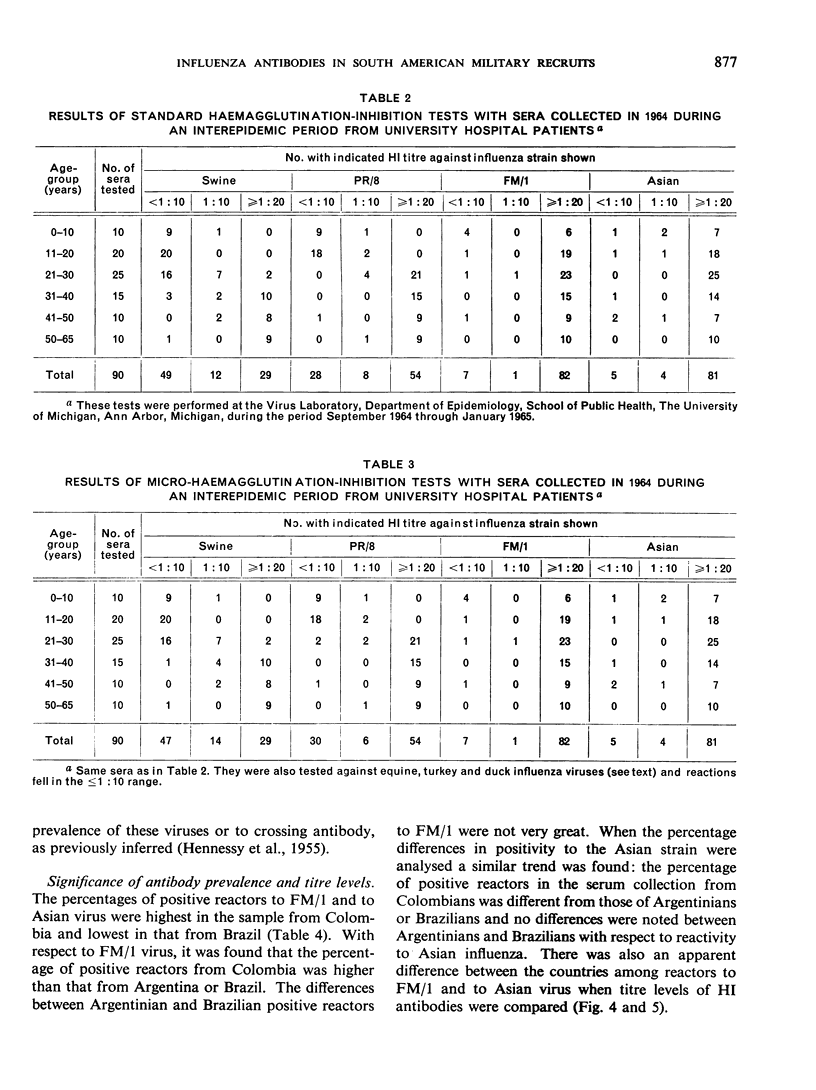
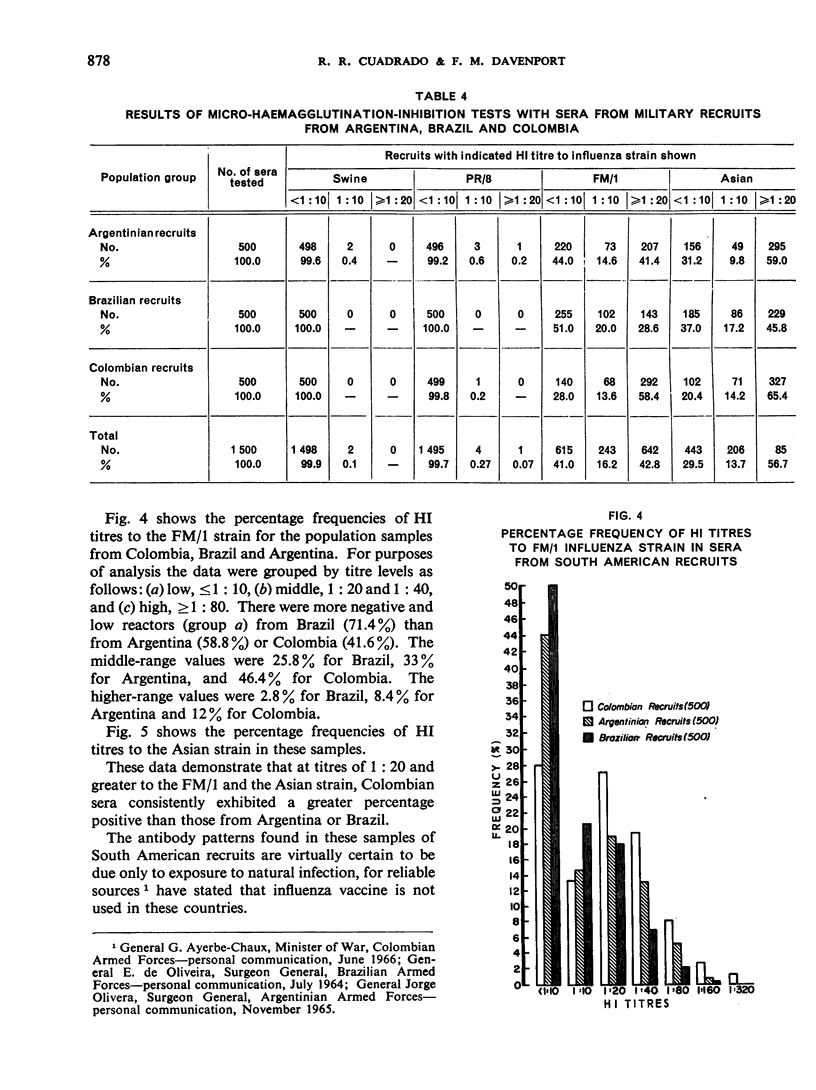
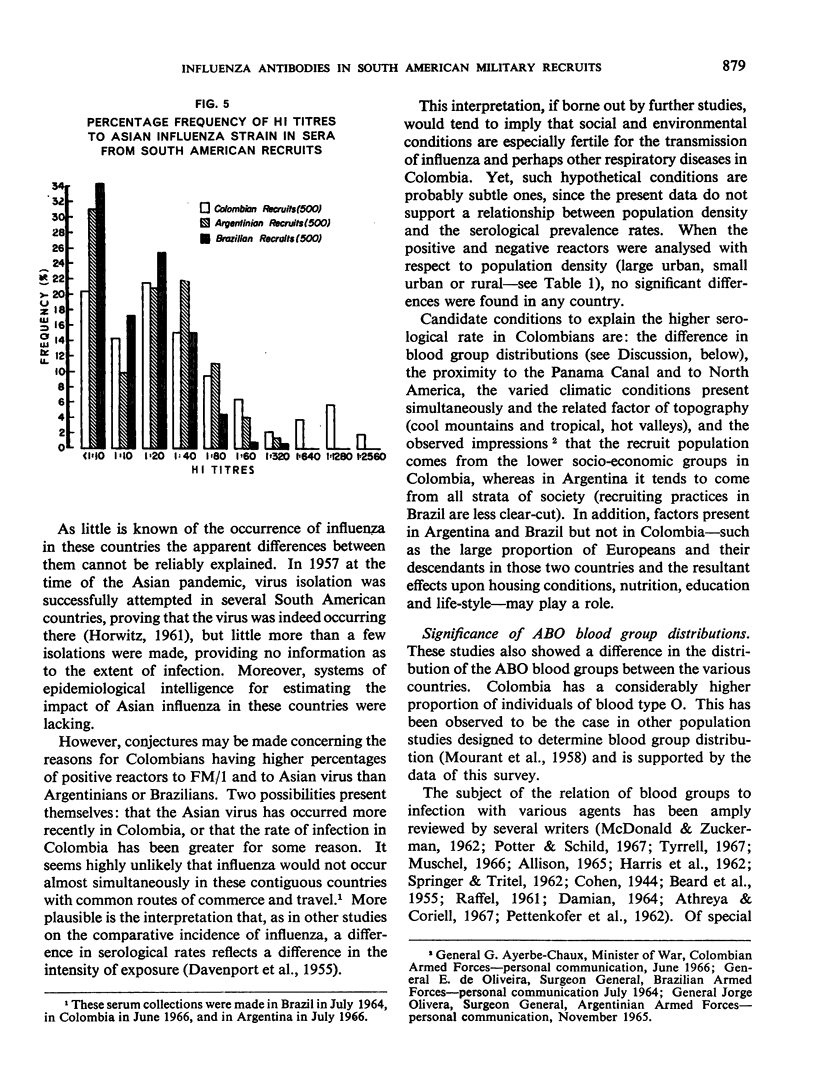
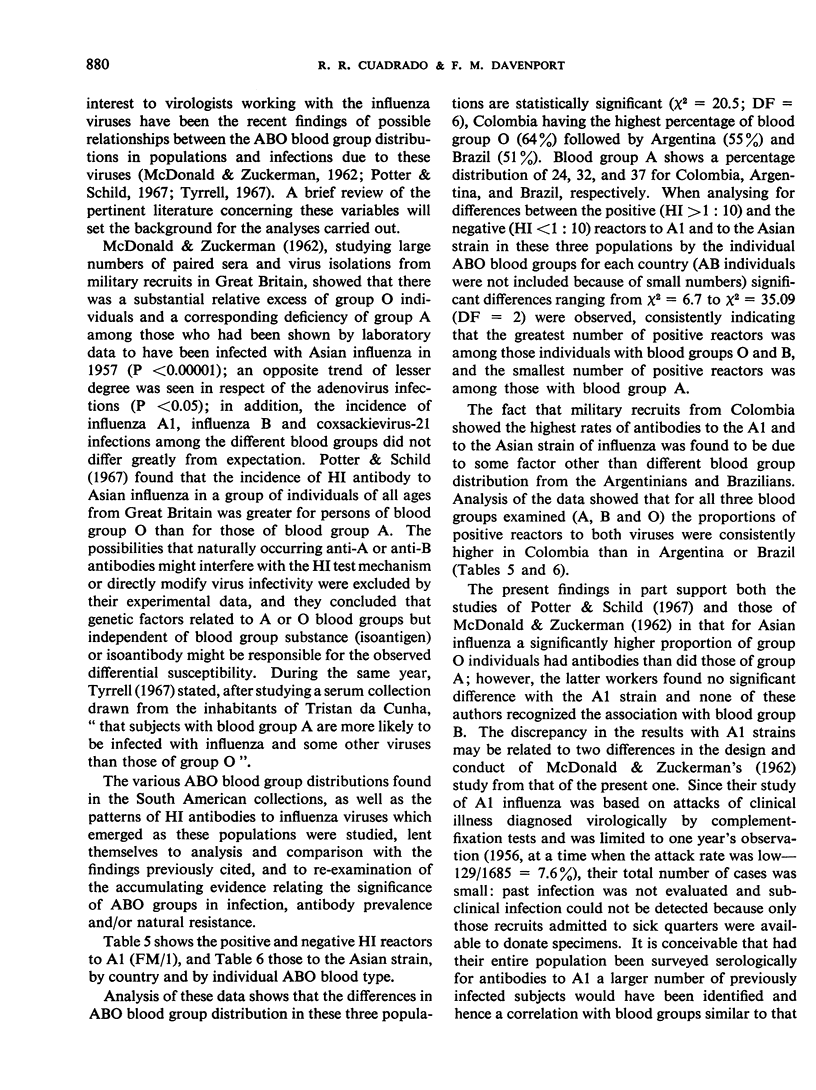
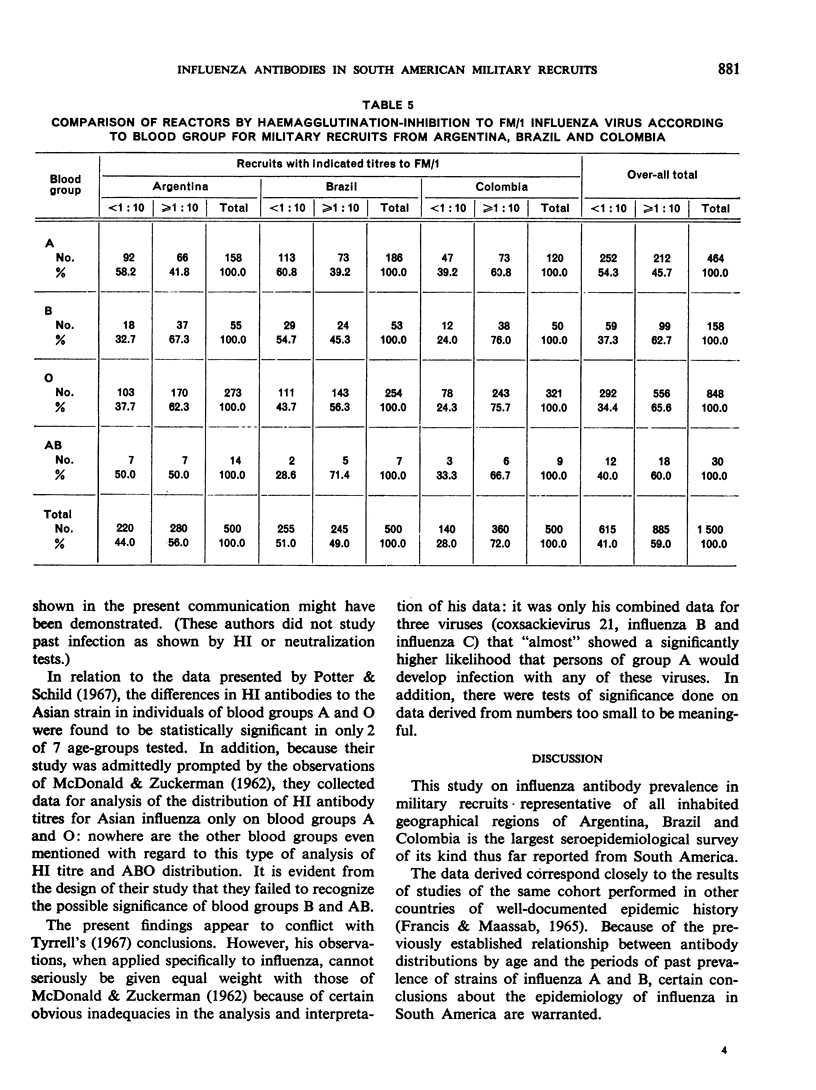
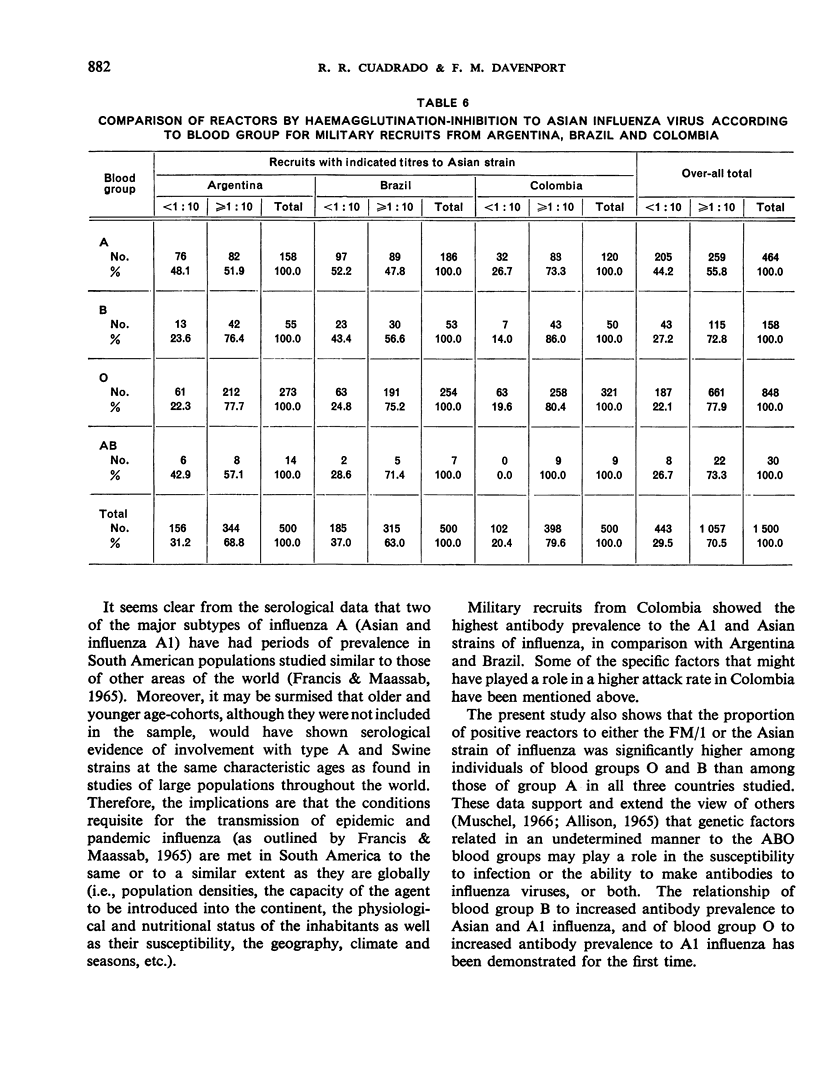
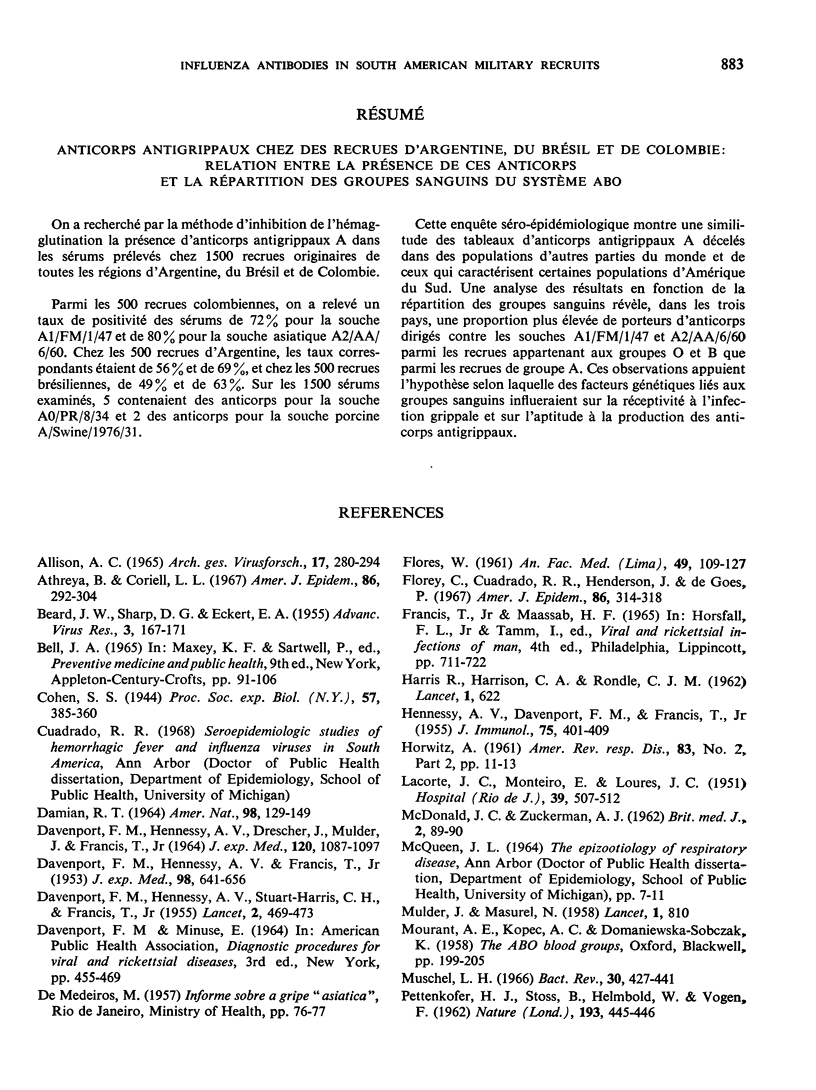
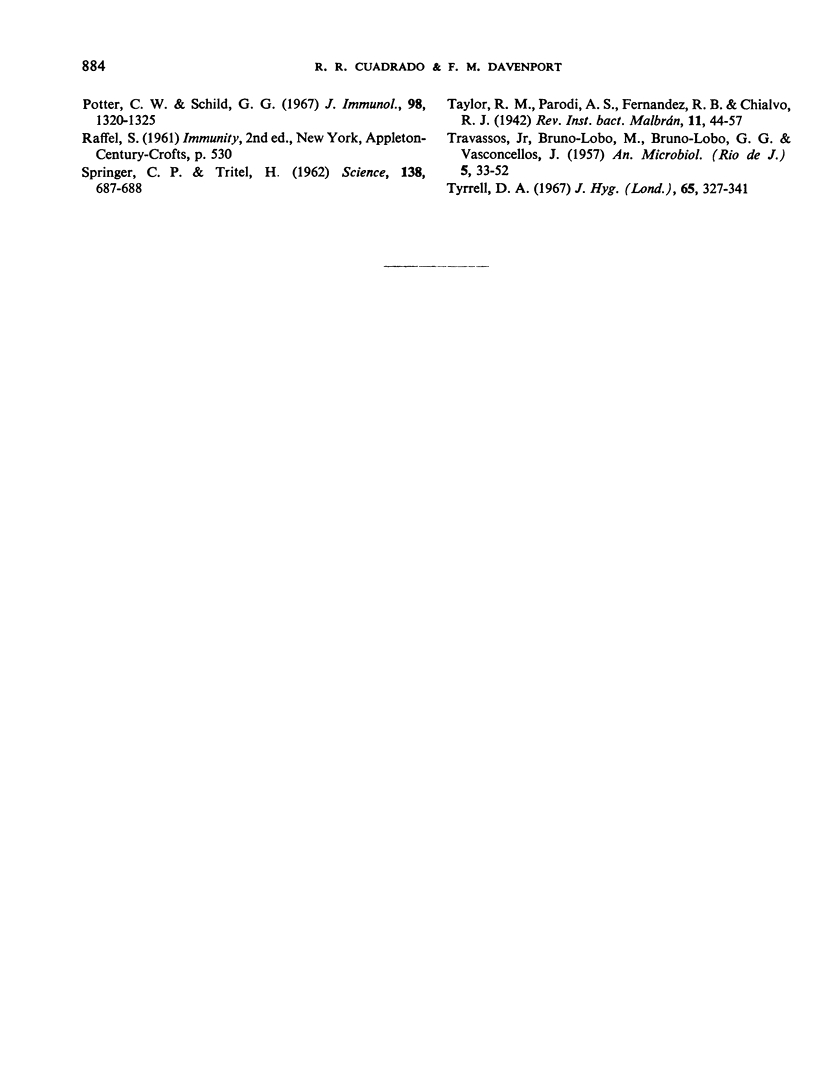
Images in this article
Selected References
These references are in PubMed. This may not be the complete list of references from this article.
- Allison A. C. Genetic factors in resistance against virus infections. Arch Gesamte Virusforsch. 1965;17(2):280–294. doi: 10.1007/BF01267912. [DOI] [PubMed] [Google Scholar]
- Athreya B. H., Coriell L. L. Relation of blood groups to infection. I. A survey and review of data suggesting possible relationship between malaria and blood groups. Am J Epidemiol. 1967 Sep;86(2):292–304. doi: 10.1093/oxfordjournals.aje.a120739. [DOI] [PubMed] [Google Scholar]
- DAVENPORT F. M., HENNESSY A. V., DRESCHER J., MULDER J., FRANCIS T., Jr FURTHER OBSERVATIONS ON THE RELEVANCE OF SEROLOGIC RECAPITULATIONS OF HUMAN INFECTION WITH INFLUENZA VIRUSES. J Exp Med. 1964 Dec 1;120:1087–1097. doi: 10.1084/jem.120.6.1087. [DOI] [PMC free article] [PubMed] [Google Scholar]
- DAVENPORT F. M., HENNESSY A. V., FRANCIS T., Jr Epidemiologic and immunologic significance of age distribution of antibody to antigenic variants of influenza virus. J Exp Med. 1953 Dec;98(6):641–656. doi: 10.1084/jem.98.6.641. [DOI] [PMC free article] [PubMed] [Google Scholar]
- DAVENPORT F. M., HENNESSY A. V., STUART-HARRIS C. H., FRANCIS T., Jr Epidemiology of influenza; comparative serological observations in England and the United States. Lancet. 1955 Sep 3;269(6888):469–474. doi: 10.1016/s0140-6736(55)93328-6. [DOI] [PubMed] [Google Scholar]
- Flores W., Cornejo-Ubillus J. R., Arce M. Encuesta serológica contra los virus de la influenza. Estudios en la población de Lima metropolitana 1959-1960. An Fac Med Lima. 1966 Mar;49(1):109–127. [PubMed] [Google Scholar]
- Florey C. du V., de Goes P. A nationwide serum survey of Brazilian military recruits, 1964. 1. Method and sampling results. Am J Epidemiol. 1967 Sep;86(2):314–318. doi: 10.1093/oxfordjournals.aje.a120741. [DOI] [PubMed] [Google Scholar]
- HARRIS R., HARRISON G. A., RONDLE C. J. Vaccinia and human blood-group-A substance. Lancet. 1962 Mar 24;1(7230):622–622. doi: 10.1016/s0140-6736(62)91607-0. [DOI] [PubMed] [Google Scholar]
- HENNESSY A. V., DAVENPORT F. M., FRANCIS T., Jr Studies of antibodies to strains of influenza virus in persons of different ages in sera collected in a postepidemic period. J Immunol. 1955 Nov;75(5):401–409. [PubMed] [Google Scholar]
- LACORTE J. G., MONTEIRO E., LOURES J. C. Identificaço do virus da influenza da epidemia de 1949 no Rio de Janeiro. Hospital (Rio J) 1951 Apr;39(4):507–512. [PubMed] [Google Scholar]
- MULDER J., MASUREL N. Pre-epidemic antibody against 1957 strain of Asiatic influenza in serum of older people living in the Netherlands. Lancet. 1958 Apr 19;1(7025):810–814. doi: 10.1016/s0140-6736(58)91738-0. [DOI] [PubMed] [Google Scholar]
- McDonald J. C., Zuckerman A. J. ABO Blood Groups and Acute Respiratory Virus Disease. Br Med J. 1962 Jul 14;2(5297):89–90. doi: 10.1136/bmj.2.5297.89. [DOI] [PMC free article] [PubMed] [Google Scholar]
- Muschel L. H. Blood groups, disease, and selection. Bacteriol Rev. 1966 Jun;30(2):427–441. doi: 10.1128/br.30.2.427-441.1966. [DOI] [PMC free article] [PubMed] [Google Scholar]
- PETTENKOFER H. J., STOESS B., HELMBOLD W., VOGEL F. Alleged causes of the present-day world distribution of the human ABO blood groups. Nature. 1962 Feb 3;193:445–446. doi: 10.1038/193445a0. [DOI] [PubMed] [Google Scholar]
- Potter C. W., Schild G. C. The incidence of HI antibody to Influenza virus A2/Singapore/ 1/57 in individuals of blood groups A and O. J Immunol. 1967 Jun;98(6):1320–1325. [PubMed] [Google Scholar]
- SPRINGER G. F., TRITEL H. Blood group A active substances in embryonated chicken eggs and their relation to egggrown virus. Science. 1962 Nov 9;138(3541):687–688. doi: 10.1126/science.138.3541.687. [DOI] [PubMed] [Google Scholar]
- Tyrrell D. A., Peto M., King N. Serological studies on infections by respiratory viruses of the inhabitants of Tristan da Cunha. J Hyg (Lond) 1967 Sep;65(3):327–341. doi: 10.1017/s002217240004585x. [DOI] [PMC free article] [PubMed] [Google Scholar]



